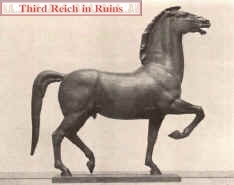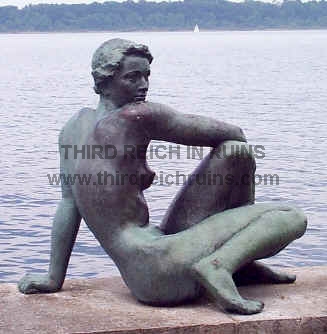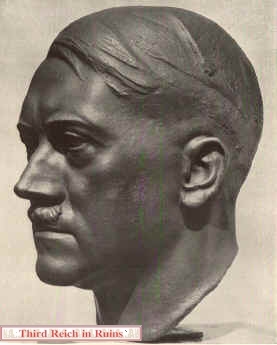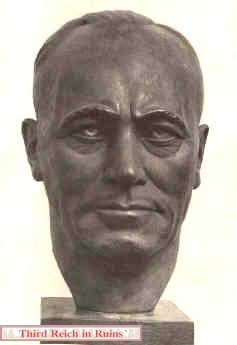|
Haus der Deutschen Kunst,
Munich
Part 4 -- Sculpture
The premier sculptors of the
Third Reich (that is, those who were Hitler's favorites) were Arno Breker, Josef Thorak,
and Fritz Klimsch. Thorak and Breker were multi-talented, working in stone and metal with
themes varying from the heroic to nudes, while Klimsch did mainly nudes. (Note
- copyrights to the works of Arno Breker and Josef Thorak are held by the Europäische
Kultur Stiftung and Arno-Breker-Museum in Bonn; used here by permission.
Books and videos on Arno Breker are available from the museum - contact Joe
Bodenstein at MARCO-VG@gmx.de.)

|

|
| Thorak's works were
often monumental, particularly those meant to grace the autobahns and the Nazi Party Rally Grounds in Nürnberg, so his studio had to be
very large. The photo on the left shows Thorak working on an autobahn sculpture called
"Monument to Work." The drawing on the right, from a 1938 issue of the Berliner
Illustrierte Zeitung newspaper, shows the inside of Thorak's studio. The huge scale
can be seen from the minute size of the actual man and horse in the center foreground. The
monuments under work were meant for the Märzfeld military demonstration area in Nürnberg
(the figure on the right is "Siegesgöttin" (Goddess of Victory). A model of
this collection, which was never installed, is shown below. Thorak's "Fahnenträger"
and "Lanzenträger" were also meant for the Märzfeld.
Click here to see then-and-now views
of Thorak's studio. |


|

|
| On the
left, a view taken on the opening day of the 1938 art exhibit; in the
background is a model of Thorak's "Siegesgöttin." On the right,
another view of Thorak at work on "Denkmal der Arbeit" (Monument to
Work). |

|

|
| On the
left, a model of Thorak's "Denkmal der Arbeit" (Monument to
Work), with an artist's conception of the work in place - this work was to
be placed in the median at the southern entrance to the autobahn system,
at the Austria border near Salzburg. See the pictures above of Thorak working on the full-size
sculpture (which was never finished). |

|

|

|
Arno Breker's works
were also widely used to decorate government buildings. These two statues flanked the
entrance to the New Reichs Chancellory in Berlin. On the left is "Die Partei"
(1939) and on the right is "Die Wehrmacht" (1939). (Center photo from Das
Bauen im neuen Reich by Gerdy Troost, Bayreuth, 1938 ed.) |

Honor Guard of the Leibstandarte-SS Adolf Hitler
(Hitler's Body Guards)
in front of "Die Wehrmacht" in the Reichskanzlei Ehrenhof (Court of Honor)

|

|
| Military and government
themes were favorites at all the exhibitions. On the left is "HJ-Trommler"
(Hitler Jugend Drummer) by Anni Spetzler-Proßchwitz, 1938; on the right is
"Hoheitsadler" (National Eagle) by Hanns Goebl, 1941. |
|

|

|
|
"LMG-Schütze" (Light Machinegun Gunner) by Bernd Hartmann-Wiedenbrück,
1941 |
"Aufstürmender
Grenadier" (Assaulting Grenadier) by Bernd Hartmann-Wiedenbrück,
1943 |
 |
 |
"Nach dem Kampf"
(After the Battle) by Hans Bühler, 1943 |
"In
Memoriam" by Paul Bronisch, 1941 |

|

|

|
Some artists
portrayed animals. On the left is Fritz Behn's "Adler" (Eagle), 1939; in the
center is Emil Manz's "Tiger," 1938; on the right is Josef Thorak's
"Pferd" (Horse), 1939. Two of Thorak's bronze horses graced the garden entrance
to Hitler's Reichskanzlei in Berlin. |

Thorak's "Pferd" in the garden of the
Reichskanzlei in Berlin.
-

|

|
"Fahnenträger"
(Standard Bearer) by Josef Thorak, 1937 (another work meant for the Märzfeld
in Nürnberg) |
"Drachentöter" (Dragon
Slayer) by Franz Josef Mikorey |
-

|

|
"Die Schauende" (The Looker) by Fritz Klimsch, 1937
(the model was Martha Nabel from Berlin). |

|

|
"Die
Schauende" still exists, as decoration on the terrace overlooking Lake Chiemsee in
southern Bavaria, behind the former Autobahn rest stop.
Click here to
view another similar work by Klimsch, that also still exists. |
-

|

|
"Genius
des Sieges" (Genius of Victory) by Adolf Wamper, 1940 |
"Deutsche Waffe" (German
Weapon) by Hias Lautenbacher, 1941 |

|

|

|
Neptune
Fountain in Munich, by Josef Wackerle, then and now. On the right is
another fountain work by Wackerle, this one at the Ernst
Sachs Bad in Schweinfurt. |

|

|
Bust of Hitler, by Ferdinand
Liebermann, 1937 |
Bust of Field Marshall Rommel, by
Fritz Berberich, 1943 |
 Return to Part 1 Return to Part 1
 Return
to the Third Reich in Ruins homepage
Return
to the Third Reich in Ruins homepage
|
